
Station Name: SIGGLESTHORNE[Source: Mark Dyson]
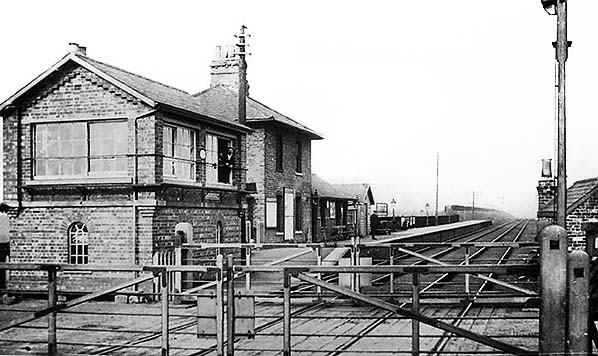 Sigglesthorne station looking north-east at the down platform from the level crossing c1905. The small brick building on the right is the weigh office at the entrance to the goods yard.
Photo from John Mann collection 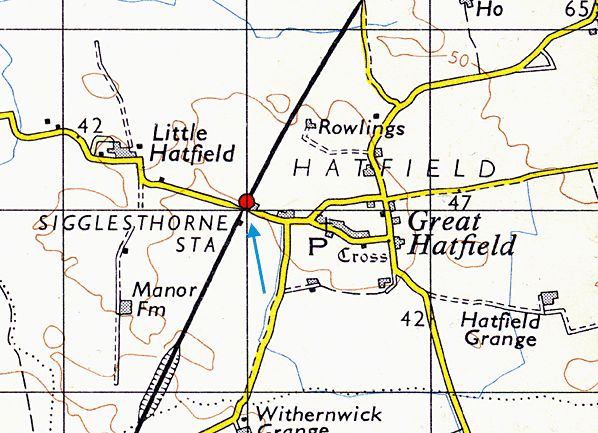
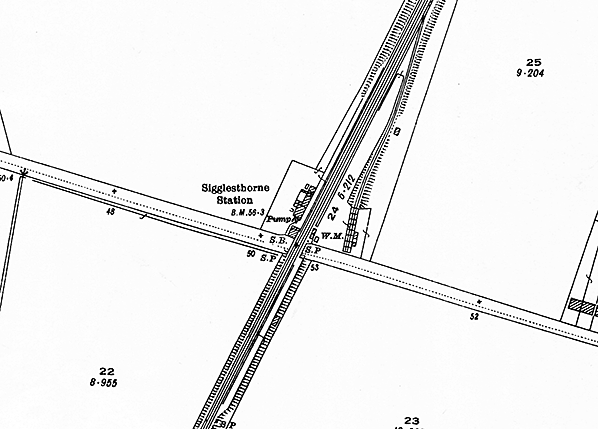
1921 1:2,500 OS map. The line has been doubled and a second up platform has been provided to the south of the level crossing. The siding running onto the coal drops has been realigned to accommodate a dock.
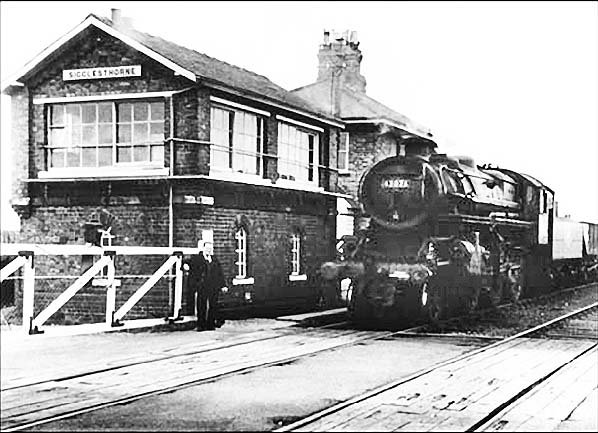 A southbound goods service is seen at Sigglesthorne station c1950s. It is on the wrong line so may be shunting.

Looking north-east from the up platform across the level crossing at Sigglesthorne station c.late 1960s. The signal box seen in the picture above has been demolished. The staggered platform are clearly seen in this view. The track can still be seen embedded in the road.
Photo from Duncan Chandler's Flickr photostream 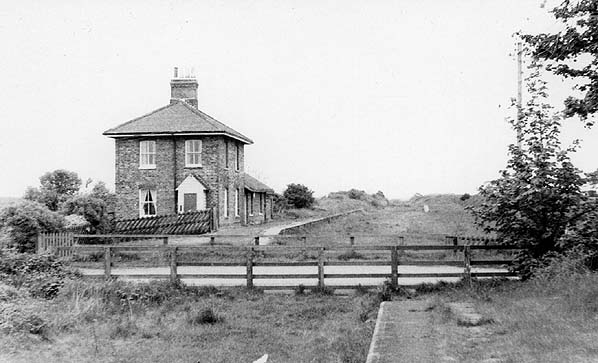
4.jpg)
Sigglesthorne station looking north-east in October 1985; the up platform is seen on the right.
Photo by Robert Woolford 
Sigglesthorne
stationmaster's house and waiting room from the Hull platform, looking towards Hornsea,
in April 1991.
Photo by Mark Dyson 8.jpg)
Looking north-east from the site of the level crossing along the down platform at Sigglesthorne station
in January 2009. Photo
by Mark Dyson
6.jpg)
Looking south-west along the down platform at Sigglesthorne station in January 2009.
Photo by Mark Dyson 7.jpg)
The station house and buildings on the Sigglesthorne down platform in January 2009.
Photo by Mark Dyson 5.jpg) The Hornsea Rail Trail is diverted onto the goods dock opposite the down platform and along the access road to the goods yard. It rejoins the line on the far side of the level crossing.
Photo by Mark Dyson 10.jpg)
Sigglesthorne up platform looking south-west in July 2017. The Hornsea Rail Trail runs through the station site.
Photo
by Darren Bailey
12.jpg) Sigglesthorne
station buildings on the down platform in July 2017
Photo
by Darren Bailey
 Home
Page Home
Page
|
 The goods yard was sited opposite the platform and comprised two sidings, one running parallel with the running line and the second running up onto coal drops. The parallel siding was realigned to the east when the line was doubled. At some time other siding was also realigned to allow a dock to be built between the two sidings. Goods services were withdrawn from 11.10.1963.
The goods yard was sited opposite the platform and comprised two sidings, one running parallel with the running line and the second running up onto coal drops. The parallel siding was realigned to the east when the line was doubled. At some time other siding was also realigned to allow a dock to be built between the two sidings. Goods services were withdrawn from 11.10.1963. The first sod was turned by Wade on 8.10.1862. Problems were
encountered during construction due to the nature of the local
soil; there were further issues with poor workmanship and materials
used by the contractors. A late change of plan saw the line
extended from the proposed terminus at Hornsea Bridge to the
seafront; this meant construction of an embankment which required
the ground to be piled adding substantially to the already escalating
construction costs.
The first sod was turned by Wade on 8.10.1862. Problems were
encountered during construction due to the nature of the local
soil; there were further issues with poor workmanship and materials
used by the contractors. A late change of plan saw the line
extended from the proposed terminus at Hornsea Bridge to the
seafront; this meant construction of an embankment which required
the ground to be piled adding substantially to the already escalating
construction costs.
 The line was constructed as a single track but was doubled
throughout in the early 1900s. Diesel railcars were introduced
from 71.1957 and operated local services from that date. Centralised
Traffic Control (automated signaling and level crossings) was
proposed in the early 1960's, but this was overtaken by the
'Beeching Report'. Closure to passengers came on 19.10.1964,
with Goods services to Hornsea Bridge continuing until 3.5.1965.
The line was constructed as a single track but was doubled
throughout in the early 1900s. Diesel railcars were introduced
from 71.1957 and operated local services from that date. Centralised
Traffic Control (automated signaling and level crossings) was
proposed in the early 1960's, but this was overtaken by the
'Beeching Report'. Closure to passengers came on 19.10.1964,
with Goods services to Hornsea Bridge continuing until 3.5.1965. 1891 1:2,500 OS map shows the original layout of Sigglesthorme station with a single platform on the down side. There are two sidings opposite the platform, one parallel to the running tine and the other running onto coal drops.
1891 1:2,500 OS map shows the original layout of Sigglesthorme station with a single platform on the down side. There are two sidings opposite the platform, one parallel to the running tine and the other running onto coal drops.thumb9.jpg)
thumb13.jpg)
thumb14.jpg)
thumb12.jpg)
thumb11.jpg)
